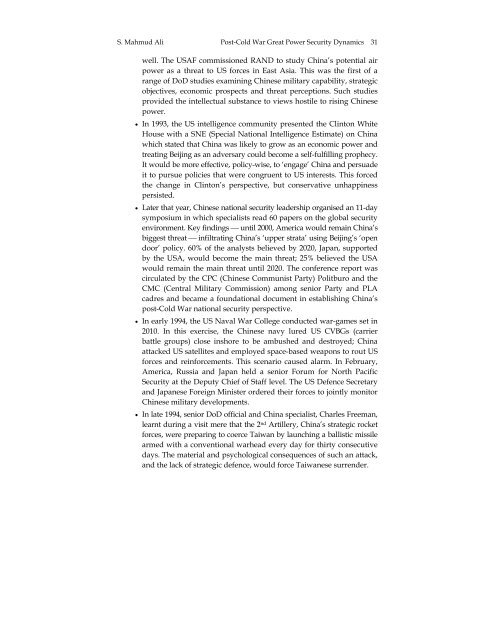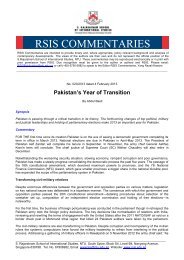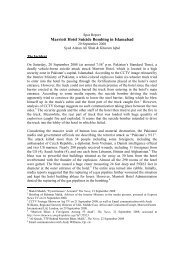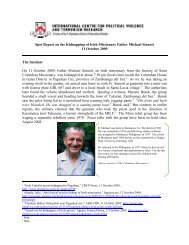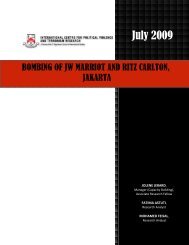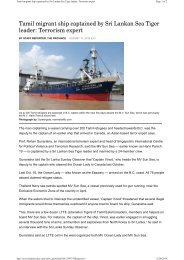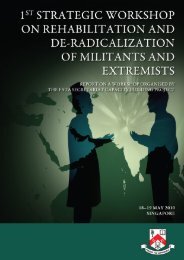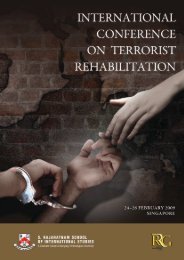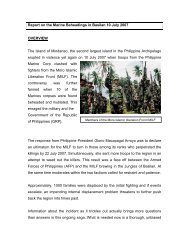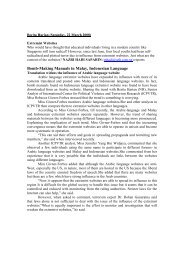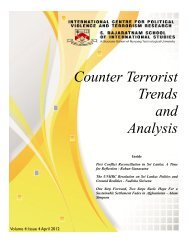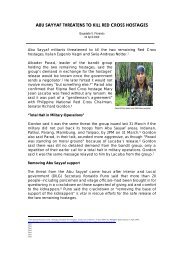Peace and Security Review, Vol.1 No. 2 - International Centre for ...
Peace and Security Review, Vol.1 No. 2 - International Centre for ...
Peace and Security Review, Vol.1 No. 2 - International Centre for ...
Create successful ePaper yourself
Turn your PDF publications into a flip-book with our unique Google optimized e-Paper software.
S. Mahmud Ali Post-Cold War Great Power <strong>Security</strong> Dynamics 31<br />
well. The USAF commissioned RAND to study China’s potential air<br />
power as a threat to US <strong>for</strong>ces in East Asia. This was the first of a<br />
range of DoD studies examining Chinese military capability, strategic<br />
objectives, economic prospects <strong>and</strong> threat perceptions. Such studies<br />
provided the intellectual substance to views hostile to rising Chinese<br />
power.<br />
• In 1993, the US intelligence community presented the Clinton White<br />
House with a SNE (Special National Intelligence Estimate) on China<br />
which stated that China was likely to grow as an economic power <strong>and</strong><br />
treating Beijing as an adversary could become a self-fulfilling prophecy.<br />
It would be more effective, policy-wise, to ‘engage’ China <strong>and</strong> persuade<br />
it to pursue policies that were congruent to US interests. This <strong>for</strong>ced<br />
the change in Clinton’s perspective, but conservative unhappiness<br />
persisted.<br />
• Later that year, Chinese national security leadership organised an 11-day<br />
symposium in which specialists read 60 papers on the global security<br />
environment. Key findings ⎯ until 2000, America would remain China’s<br />
biggest threat ⎯ infiltrating China’s ‘upper strata’ using Beijing’s ‘open<br />
door’ policy. 60% of the analysts believed by 2020, Japan, supported<br />
by the USA, would become the main threat; 25% believed the USA<br />
would remain the main threat until 2020. The conference report was<br />
circulated by the CPC (Chinese Communist Party) Politburo <strong>and</strong> the<br />
CMC (Central Military Commission) among senior Party <strong>and</strong> PLA<br />
cadres <strong>and</strong> became a foundational document in establishing China’s<br />
post-Cold War national security perspective.<br />
• In early 1994, the US Naval War College conducted war-games set in<br />
2010. In this exercise, the Chinese navy lured US CVBGs (carrier<br />
battle groups) close inshore to be ambushed <strong>and</strong> destroyed; China<br />
attacked US satellites <strong>and</strong> employed space-based weapons to rout US<br />
<strong>for</strong>ces <strong>and</strong> rein<strong>for</strong>cements. This scenario caused alarm. In February,<br />
America, Russia <strong>and</strong> Japan held a senior Forum <strong>for</strong> <strong>No</strong>rth Pacific<br />
<strong>Security</strong> at the Deputy Chief of Staff level. The US Defence Secretary<br />
<strong>and</strong> Japanese Foreign Minister ordered their <strong>for</strong>ces to jointly monitor<br />
Chinese military developments.<br />
• In late 1994, senior DoD official <strong>and</strong> China specialist, Charles Freeman,<br />
learnt during a visit mere that the 2 nd Artillery, China’s strategic rocket<br />
<strong>for</strong>ces, were preparing to coerce Taiwan by launching a ballistic missile<br />
armed with a conventional warhead every day <strong>for</strong> thirty consecutive<br />
days. The material <strong>and</strong> psychological consequences of such an attack,<br />
<strong>and</strong> the lack of strategic defence, would <strong>for</strong>ce Taiwanese surrender.<br />
<strong>Vol.1</strong>, <strong>No</strong>.2 2008 pp.27-47


